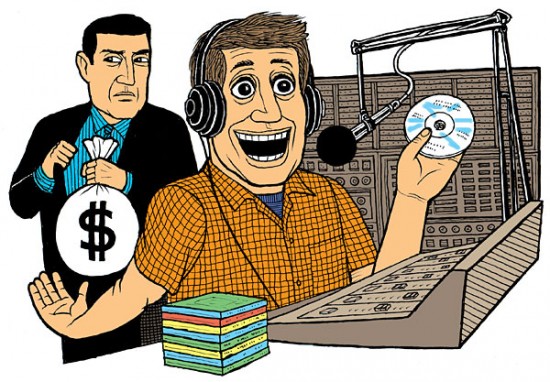
Ah, nostalgia…it just ain’t what it used to be. Used to be that payola was just something that sleazy record promoters slipped to radio DJs to turn a mediocre pop song into a “smash hit”.
Well, guess what? That basic concept has proved so lucrative that it has since expanded to engulf the financial sphere. Yes, kiddies, try not to look so shocked…apparently, Standard and Poor is the new radio DJ. And if you don’t slip ‘em a fat envelope, guess what happens to your credit rating?
When Standard and Poor’s announced its dreaded downgrade of U.S. Treasury bonds from their traditional AAA status last Friday, perhaps all the investors, legislators and citizens who trembled ought to have laughed instead. Perhaps they should ask whether S&P, as one of the handful of ratings agencies whose dubious conduct spurred the financial crisis, might still esteem Uncle Sam’s credit if only the Treasury doled out enormous fees to the agencies for those ratings – just like the bankers whose junk securities they had deemed impeccably AAA paid for those ratings.
Indeed, it seems reasonable to wonder if the weekend threat by top S&P executives to further downgrade government bonds is actually a solicitation for the same lucrative fees that bankers paid for those false stamps of approval on their mortgage-backed securities back before the housing bubble exploded. A famous old New York politician once disparaged the practice of law as an exercise in “learning how to call a bribe a fee” — a description that might well apply to the ratings business during the years leading up to the crisis.
[…]
Recent investigations by the Financial Crisis Inquiry Commission and the Senate Permanent Subcommittee on Investigations have raised fundamental questions about why and whether anyone still retains confidence in the opinions issued by S&P and Moody’s. To say that their sterling ratings of credit default obligations and other exotic mortgage-based loans were “inaccurate” is far too polite, particularly because the profits and stock prices of the ratings firms depended so heavily on the fees they earned from the investment banks whose securities they graded.
The Financial Crisis Inquiry Commission’s final report succinctly states the basic facts: “The three credit rating agencies were key enablers of the financial meltdown. The mortgage-related securities at the heart of the crisis could not have been marketed and sold without their seal of approval…Their ratings helped the market soar and their downgrades through 2007 and 2008 wreaked havoc across markets and firms.” Former FCIC commission member Byron Georgiou, now running for the US Senate from Nevada, says he was “incredulous” when he learned of the S&P downgrade, noting acidly how the ratings agencies fattened themselves on payments from the same Wall Street banks that issued the worthless securities they had repeatedly endorsed.
Echoing the FCIC report, the Senate subcommittee found that both S&P and Moody’s knew as early as 206 that sub-prime mortgages were extremely risky, but continued to issue “investment-grade ratings” on securities based on those mortgages for several months. The subcommittee sharply criticized the “issuer pays” model used by the ratings agencies, the foundation of their unsound relationships with Wall Street companies and their feckless endorsements of products that led to the crash.
How does that line go? “It’s just spend a buck to make a buck/You don’t really give a flying fuck…”?
Oh heavens me. I feel a song coming on. Take it away, Bruce:
Looks like the IMF isn’t the only dirty MF in the alphabet soup. Move over, Bretton Woods bankers, and make way for the credit ratings agencies. Today, S & P…tomorrow, who knows what other set of initials will be holding out their claws for the massive payola?
And guess who will be on the hook for it, as usual?
PS: Paul Krugman has also chimed in…
America’s large budget deficit is, after all, primarily the result of the economic slump that followed the 2008 financial crisis. And S.& P., along with its sister rating agencies, played a major role in causing that crisis, by giving AAA ratings to mortgage-backed assets that have since turned into toxic waste.
Nor did the bad judgment stop there. Notoriously, S.& P. gave Lehman Brothers, whose collapse triggered a global panic, an A rating right up to the month of its demise. And how did the rating agency react after this A-rated firm went bankrupt? By issuing a report denying that it had done anything wrong.
So these people are now pronouncing on the creditworthiness of the United States of America?
Wait, it gets better. Before downgrading U.S. debt, S.& P. sent a preliminary draft of its press release to the U.S. Treasury. Officials there quickly spotted a $2 trillion error in S.& P.’s calculations. And the error was the kind of thing any budget expert should have gotten right. After discussion, S.& P. conceded that it was wrong — and downgraded America anyway, after removing some of the economic analysis from its report.
He doesn’t mention payola, but it’s still good for another song:
